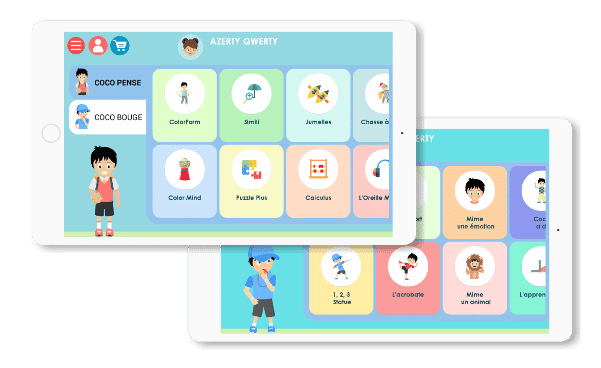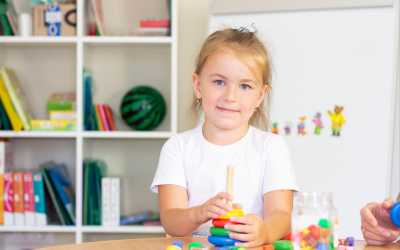With the advent of digital technologies, screens are now part of many children’s daily lives.
While excessive screen use can have negative effects on their health and development, screens can also be a source of learning and intellectual stimulation for children.
Indeed, screens enable interactive and personalized learning opportunities that can help children develop key skills, creativity and curiosity, and prepare them for the challenges of the ever-changing digital world.
In this article, we will explore how screens can be used effectively and responsibly for children’s learning, offering practical tips and real-world examples for parents and educators.
How can screens be used constructively for children’s learning?
Screens can be used constructively for children’s learning in a variety of ways. First, the screens provide access to a multitude of online educational resources, such as educational videos, educational applications and interactive learning games. These resources can help children develop skills in a variety of areas, such as math, reading, science and language.
Second, screens require personalized learning, allowing children to work at their own pace and adapt to their individual skill level.
For example, some online educational games automatically adjust the difficulty according to the child’s skills, offering challenges adapted to their level.
Finally, screens can encourage creativity and self-expression in children. Drawing and music-making apps, for example, can help children explore their creativity and develop their confidence.
However, it is important to note that the use of screens for learning must be closely supervised and monitored. Parents and educators should ensure that the online resources used are of high quality, age-appropriate, and that they limit screen time to avoid excessive exposure.
In sum, screens can be used constructively for children’s learning, providing access to online educational resources, supporting personalized learning, and fostering creativity and self-expression.
However, it is important to monitor and limit screen use to ensure healthy and balanced learning.
What educational games and apps help children learn and develop?
There are a wide variety of educational games and apps that can help children learn and develop in different areas.
Educational games are designed to be both fun and informative, which can help children focus and stay motivated while learning.
-
Mathematics
Games such as DragonBox and Mathletics can help children understand basic concepts and develop problem-solving skills.
These games can be adapted to different skill levels and ages, allowing children to progress at their own pace.
-
The language
Apps such as Epic! and Reading Eggs can help children improve their reading comprehension and vocabulary.
These apps offer a variety of books suitable for different skill levels, as well as interactive activities to reinforce reading skills.
-
The sciences
Games such as Science Buddies and The Elements can help children explore scientific concepts in an interactive way. These apps offer hands-on experiments and educational games to help children understand basic scientific principles and develop their curiosity.
-
Foreign languages
Applications such as Duolingo and Babbel can help children learn a new language in a fun and interactive way. These apps offer lessons tailored to different skill levels, as well as games and activities to help children practice their pronunciation and comprehension.
-
Creativity
Finally, applications such as Scratch and Tynker can help children learn programming and develop their creativity by tuning their own games and interactive animations.
It is important to note that the use of educational games and apps should be closely supervised and monitored by parents and educators.
It is also important to ensure that the games and applications used are appropriate for the child’s age and ability, and that screen use is limited to avoid excessive exposure.
There are also educational applications that bring together a wide variety of fun and educational activities within the same interface.
This is the case with the COCO THINKS and COCO MOVES application, which offers more than 30 educational games and 8 sports games to help children learn while having fun.
In sum, educational games and apps can be valuable tools to help children learn and develop in different areas.
By combining online activities with in-person activities and limiting screen use, parents and educators can help children benefit from using digital technologies for learning.
Which apps impact children, youth and teens the most?
Keep in mind that the impact of apps on children and teens can vary depending on age, interests and individual preferences.
However, there are some applications that tend to have a greater impact than others.
-
For young children
Apps such as YouTube Kids, Toca Boca and PBS Kids offer a variety of educational and entertainment content to help them learn and develop.
These applications offer videos, games and interactive activities adapted to the child’s age and skills.
-
For teenagers
Social networks such as Snapchat, Instagram and TikTok are extremely popular.
These applications allow teens to connect with their peers, share photos and videos, and express their creativity.
However, it is important to note that these applications can also have effects, such as exposure to inappropriate or offensive content, and pressure to maintain an online self-image.
-
For children and teenagers
Video games such as Fortnite, Minecraft, and Roblox are also very popular among children and teens. While they can be used to encourage creativity, collaboration and skill development, they can also be addictive and lead to screen overuse. In addition, some games may contain violent or inappropriate content that can affect children’s behaviors and attitudes.
Messaging apps such as WhatsApp, Messenger and iMessage are often used to communicate with peers and family. While they can be useful for maintaining social connections, they can also be used for harassment, spreading inappropriate content and communicating with strangers.
Video streaming apps such as YouTube, Netflix and Disney+ are also popular. Their purpose is to help individuals watch educational and entertaining television programs and movies, they may also contain inappropriate or violent content that can affect the mental and emotional health of children.
In conclusion, it is important for parents and educators to monitor the use of mobile applications among children, youth and adolescents, ensuring that the applications used are appropriate for the age and skills of the child, and limiting the use of screens. Parents can also encourage children to use educational and developmentally positive apps, providing healthy alternatives and educating about the potential risks associated with digital technology use.
What are the advantages of screens for learning compared to the screen-free era?
Screens have brought many benefits to learning, compared to when they were not present in everyday life. Screens can provide children and youth with easy access to information, as well as a variety of educational resources and interactive learning tools.
-
Provide access to educational programs
The displays can provide educational videos, tutorials and interactive educational programs, which can help children learn subjects such as science, math and foreign languages in a fun and engaging way.
Children can also access online encyclopedias, dictionaries and digital libraries to expand their vocabulary and general knowledge.
-
Training in technological skills
In addition, screens can help children develop technological skills that are increasingly necessary in today’s world. Skills such as typing, web navigation, and programming can be taught effectively using computer tools and interactive programs.
Compared to the screen-free era, learning can also be more collaborative and social through the use of screens. Kids can connect with classmates and teachers remotely, work together on online projects, and share information and ideas in real time.
In conclusion, screens can bring many benefits to the learning of children, youth and adolescents, including providing interactive and stimulating educational tools, as well as easy access to a large amount of information and resources. However, it is important to recognize that excessive screen use can have physical and mental health effects, especially for young children.
Parents and educators must therefore be vigilant in balancing screen use with other activities that encourage socialization, physical activity and creativity.
Discover the application COCO THINKS and COCO MOVES ©.
The COCO THINKS and COCO MOVES application contains more than 30 educational games to work on French, math, logic, memory, or attention.
In addition, the application imposes a sports break every 15 minutes of screen time to teach measured screen use.
Much smarter than a parental control!

Other articles that might interest you:
Supporting children with autism
Dynseo proposesSUPPORTING CHILDREN WITH AUTISM with COCO THINKS AND COCO MOVESDynseo and its team are very much...
Supporting DYS children with COCO THINKS and COCO MOVES
Dynseo proposesDYS disorders with COCO THINKS and COCO MOVESOur educational and pedagogical games program COCO THINKS...
Language development
Children communicate from birth with movements, crying, looking at each other or with smiles. After only a few months,...
Supporting children with Down Syndrome with Coco
Dynseo proposesDOWN SYNDROME with COCODown syndrome is a non-hereditary chromosomal abnormality that leads to the...
Supporting people after a stroke
Dynseo proposesStroke with CLINT, your brain training coachThe Dynseo team is very involved in helping people who have...
Supporting someone with Alzheimer’s
In this guide, we will detail how SCARLETT can be used for supporting someone with Alzheimer's. SCARLETT is a...
10 myths about the human brain you didn’t know
The brain is an incredible muscle, however there are many things we do not know, and what we do know is not always...
Using Digital Tools to Support Students with Special Educational Needs
Special Educational Needs (SEN) encompass a wide range of learning difficulties and disabilities that can hinder a...
Down Syndrome and Communication: Facilitating Interaction with Visual and Interactive Supports
When we think about Down syndrome, we often recognize it as a genetic condition that affects physical and cognitive...
How to Track Progress in People with Down Syndrome Using Digital Tools
Down syndrome, a genetic condition caused by the presence of an extra chromosome 21, affects approximately 1 in every...















